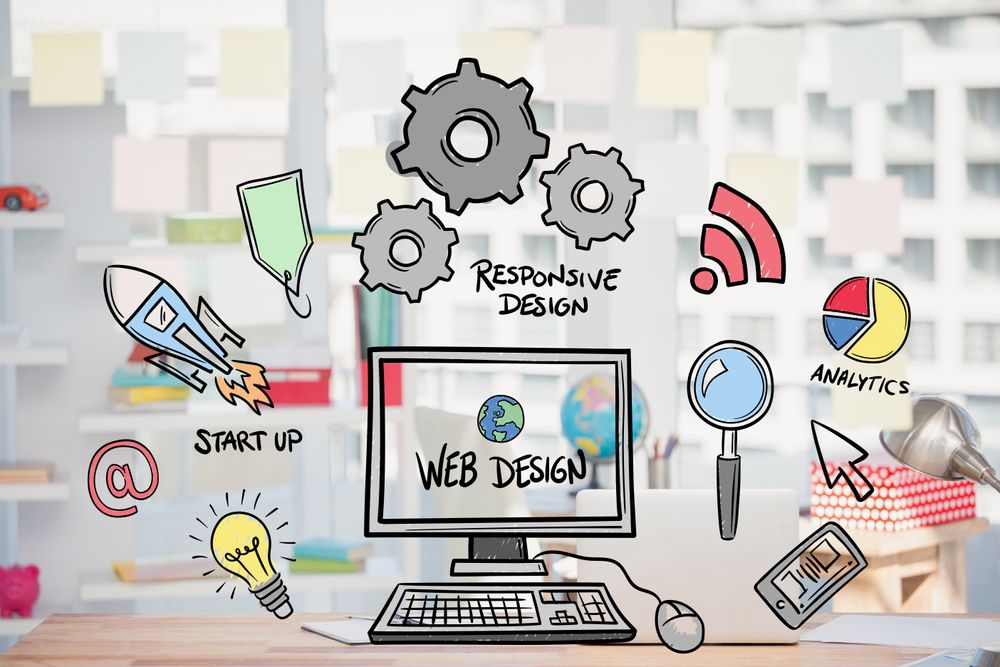The Ultimate Overview to Modern Internet Site Design Trends
In the ever-evolving electronic landscape, modern-day web site style patterns play a crucial role in shaping customer experience and interaction. From the surge of minimalist layout principles that prioritize simplicity to the effect of vibrant typography in defining brand identification, each component adds to a natural on-line existence.
Minimalist Style Concepts
Minimal layout principles stress the idea that much less is more, advocating for simplicity and functionality in visual communication. This method strips away unneeded aspects, focusing rather on necessary parts that convey the designated message effectively. By prioritizing quality, minimal design improves individual experience, permitting site visitors to browse sites effortlessly.
Core tenets of minimalist design include making use of ample white area, which develops a feeling of balance and organization. This adverse space not only directs the audience's interest to crucial elements yet likewise fosters a calming aesthetic environment. Additionally, a minimal shade combination is commonly used, utilizing single systems or soft colors to keep aesthetic communication and avoid overwhelming the user.
Typography plays an important role in minimalist design, where clear typefaces are picked for their simplicity and performance in connecting material. Inevitably, minimal layout principles cultivate a focused setting that motivates users to engage with the content, boosting the overall performance of modern-day website layout.
Strong Typography Selections
Embracing vibrant typography choices has actually become a defining attribute of modern-day web site design, as it properly catches focus and conveys solid messaging. Designers are increasingly using typography not simply as a functional element but as a crucial visual component that boosts the overall aesthetic and individual experience.

Additionally, the juxtaposition of vibrant typography with minimalist layout concepts enables striking contrasts, improving readability while maintaining aesthetic allure. Using whitespace around vibrant message even more emphasizes its significance, guaranteeing that the message reverberates with the audience.
As electronic landscapes come to be a lot more affordable, leveraging bold typography makes it possible for brand names to separate themselves and leave an enduring perception. The cautious selection of font styles and their application can evoke emotions, develop tone, and drive action, making strong typography an essential tool in contemporary website layout. Eventually, it is a powerful means to enhance storytelling and ensure that vital messages are not just seen however additionally really felt.
Mobile-first and responsive Style
Mobile-first and responsive layout has emerged as a vital principle in modern internet site advancement, showing the enhancing reliance on mobile devices for accessing on the internet material. As individual habits shifts in the direction of mobile surfing, designers should prioritize developing experiences that adjust flawlessly across numerous display sizes and resolutions.
A responsive layout makes sure that a website immediately readjusts its layout, images, and capability based on the gadget being used. Mobile-first design advocates for establishing websites at first for smaller displays, consequently scaling up to bigger screens.
Implementing mobile-first and responsive principles not just satisfies user preferences but likewise aligns with search engine optimization (SEARCH ENGINE OPTIMIZATION) practices. Major online search engine, like Google, prioritize mobile-friendly web sites in their rankings, making it critical for companies to take on these layout methods. In an affordable digital landscape, accepting receptive and mobile-first design is not just a choice; it is vital for guaranteeing access and interaction with my website a varied target market.
Engaging Microinteractions
Microinteractions play a critical role in enhancing user involvement and general web site experience, especially in the context of responsive and mobile-first design. These subtle layout elements offer immediate comments to customers, making communications more user-friendly and delightful. Instances include button animations, notification notifies, and loading indications, which not just guide customers however also create a sense of connection with the interface.
Including appealing microinteractions can considerably improve functionality by lowering cognitive lots. When customers get auditory or aesthetic comments upon carrying out activities, such as clicking a button or sending a type, they feel more positive in their selections. This promotes a smoother navigating experience, eventually boosting individual retention.

As website design patterns proceed to develop, the value of microinteractions can not be overstated. They serve as the refined yet effective touchpoints that change ordinary communications right into remarkable experiences, thus boosting the total performance of modern website design.
Sustainable Website Design Practices
Lasting internet style methods important site are ending up being significantly crucial as the digital landscape grows and ecological worries increase. Designers and programmers are recognizing their responsibility to create internet sites that not just offer user requirements but also decrease environmental effect. This technique includes several vital methods.
Firstly, optimizing energy consumption is paramount. Web sites must be designed to pack quickly and efficiently, which minimizes server power usage and enhances individual experience. Strategies such look at this web-site as picture compression, reducing HTTP requests, and utilizing modern-day coding techniques add substantially to this goal.
Secondly, picking environment-friendly organizing suppliers is essential - website design. Numerous holding business are currently powered by renewable resource resources, enabling web sites to operate in a much more sustainable manner. This choice reflects a dedication to lowering carbon footprints
Additionally, adopting a minimalist design can boost sustainability. Less elements on a web page result in less data transfer, which not only speeds up loading times yet also preserves sources.
Last but not least, promoting electronic ease of access guarantees that internet sites get to a bigger target market without unneeded bloat, lining up customer experience with environmental obligation. By incorporating these sustainable techniques, web developers can contribute positively to both customer interaction and the earth's well-being.
Final Thought
In summary, modern site design trends emphasize the assimilation of minimal principles, vibrant typography, and receptive layout to improve customer experience. Involving microinteractions add to unforgettable communications, while lasting practices promote for eco aware development. Collectively, these aspects not only raise visual allure however also improve performance, making certain that internet sites are both aesthetically striking and easy to use. Adopting these trends is vital for developing impactful digital experiences that reverberate with users in a significantly competitive on the internet landscape.
In the ever-evolving electronic landscape, contemporary internet site style fads play an essential function in forming customer experience and engagement. By focusing on clearness, minimal style boosts customer experience, enabling site visitors to navigate websites easily.
Ultimately, minimal design concepts grow a focused setting that encourages customers to engage with the web content, boosting the general performance of modern internet site style.Microinteractions play a pivotal duty in boosting customer interaction and total web site experience, especially in the context of mobile-first and receptive style.In recap, modern website layout patterns highlight the combination of minimalist concepts, bold typography, and responsive style to enhance user experience.
Comments on “Why Professional Website Design is a Key Factor in Your Marketing Strategy”